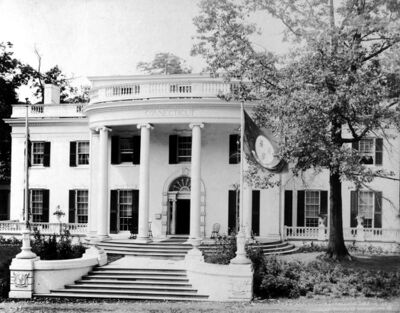Connecticut
 | |
| Location | Plateau of States |
|---|---|
| Construction | |
| Construction Cost | $31,000 ($934,937 in 2021) |
| Dates | |
| Dedication Day | May 3, 1904 |
| Architecture | |
| Architect | Edward T. Hapgood |
| Dimensions | 80' x 88' |
Connecticut's official building on the Plateau of States represented the luxurious colonial home of a Connecticut gentleman from the nineteenth century.
Before the Fair[edit | edit source]
Builders studied old reference of such structures and even used period woodwork as in its entrance doorway and large parlor. The old woodwork was almost exclusively taken from a 1760 Hubbard-Slater mansion in Norwich (some sources have stated that construction materials came from three different homes). The state pavilion was patterned after the 1810 home of Lydia Sigourney's mansion at Hartford, and the Slater house in Norwich. The building was designed to accommodate 12-15 residents.
The Connecticut building was been placed well back from the street, with circular walks and flower gardens in front. The contract for the erection of the Connecticut Building was awarded to The H. Wales Lines Company of Meriden, Conn. at a meeting of the Commission held July 9th. Work was begun on it July 20th under the direction of E.B. Moss, general superintendent of the contracting company, who, upon his return to Connecticut, left Mr. George Stretch in charge of its construction.
The intention of the contractors was to have the building completed about November 20th, but delay in supplying sundry interior requirements put off the finishing touches until December 14th.
Description[edit | edit source]
Mr. Charles N'oel Flagg of Hartford and Miss Minnie A. Lewis, of the house-decorating firm of Lewis & Muchmore of New York supervised the interior.
Inside one could see a chair that actually came over on the Mayflower (the Sigourney family did cross the Atlantic on that famous vessel). Another chair that George Washington used and a 175 year old spinet piano were on display. A bed, where Continental Congress member Oliver Ellsworth died in 1807 was featured.
The walls of the rooms on the first floor and the upper hall were hung with five different designs of exquisite silk tapestry, the gift of the Cheney Brothers, of South Manchester.
The feature exhibit in the state building was the reception hall frame, carved from the trunk of the original Charter Oak.
Official inspectors pronounced it the best-built edifice at the Exposition.
It was the rule that the building was closed to visitors at six o'clock at night, that being the custom with state buildings generally, in order that janitor service, etc., might be performed without troublesome interruption, nevertheless, whenever Connecticut visitors were announced after the regular closing hours they were cordially received and shown the utmost attention. The demands upon hostesses and other attendants were usually so continuous that they were greatly relieved when the closing hour came.
The social functions at the Connecticut Building were numerous, which included a reception to President and Mrs. Francis.
Connecticut had the credit of being the only New England State which made a dairy exhibit.
On account of the limited appropriation it was necessary to abandon the live exhibit of Connecticut in the Fish and Game Palace.
Connecticut made a good display. Fifty-eight different specimens of nuts attracted much attention.
Much interest was manifested in flint (Yankee) corn, as it was called by people of the West and South/ Many samples of this material was given to people from all parts of the United States and to foreign countries.
Connecticut also had an outstanding exhibition at the Palace of Fine Arts.
The pavilion was dedicated on May 3rd (where visitors were given a free booklet of historical sketched about the state).
David Rowland Francis closed the ceremonies with a short speech:
"Mr. Chairman, Your Excellency,Ladies and Gentlemen: This is Connecticut Day on the World's Fair Grounds, and right well has that grand old commonwealth done her duty. We have had State Days and shall have others; but none of them will be cherished with sweeter remembrances nor more sincere gratitude than this day of Connecticut. It will be treasured because of the representative delegation which the State has sent to join with us in commemorating a great event in our Country's history. It will be remembered because of the part which Connecticut has performed, not only in making the exhibits which are here today, but in building this country."
After the Fair[edit | edit source]
William and Fanny Potter moved the building to Lafayette, Indiana, when the Fair closed. Bob and Ellie Haan bought it from their son- George Potter in 1984.
In 2015, The Haans started a museum, and donated the property.
Haan Museum of Indiana Art 920 E State Street Lafayette, IN 47905
